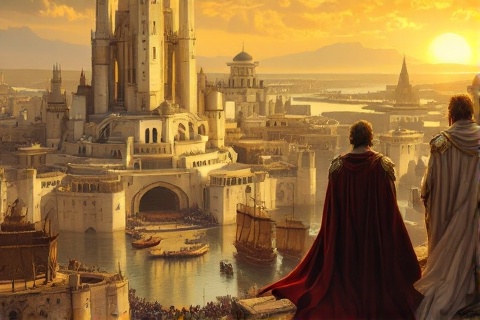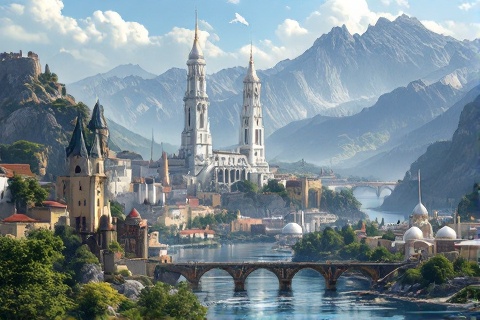
The Rise of Men in Middle-earth
Exploring the Strengths, Mysteries, and Legends of Tolkien's Secondborn
The Awakening of Men

The awakening of Men occurred in the eastern land of Hildórien as the first rays
of the Sun rose over Middle-earth at the beginning of the
First Age. While the exact location remains unknown in later
ages, this momentous event marked the coming of the Secondborn of Ilúvatar into
the world, following the long ages during which only Elves dwelt
in Middle-earth. The first Men awakened when the world was already ancient, yet
their arrival heralded profound changes in the fate of Arda.
The Gift of Men, bestowed by Ilúvatar himself, set them fundamentally apart from
the Firstborn. This gift of mortality meant that Men would not endure forever
within the world, but would instead pass beyond it after their deaths to a
destiny unknown even to the Valar. This mysterious fate became
central to their nature and influenced their entire relationship with the world
and its other inhabitants.
The earliest migrations of Men took them westward from Hildórien, following the
rising and setting of the Sun. These journeys eventually brought them into
Beleriand during the First Age, where they encountered the Elves for the first
time. The Elves called them the Atani, or Secondborn, and some among them,
particularly the Three Houses of the Edain, formed lasting
friendships with the Eldar, learning from them and adopting many of their
customs and knowledge.
The Gift of Men
The Gift of Men, though named so by the Elves, was often viewed as a burden or
curse by Men themselves, who struggled to understand its true nature and
purpose. This gift of mortality was inextricably linked to their freedom from
the bounds of fate that governed the Elves, allowing them to shape their own
destinies beyond the Music of the Ainur. Ilúvatar designed this gift as a
blessing, though its full meaning remained a matter of deep contemplation and
sometimes despair throughout the ages of Middle-earth.
Unlike the Elves, who were bound to remain within Arda until its end, Men
possessed the freedom to depart beyond the circles of the world after death.
This fundamental difference meant that their fëar (spirits) would leave the
world entirely, journeying to a destination unknown to all save Ilúvatar
himself. The Elves, in contrast, would either be reborn in
Valinor or remain in the Halls of Mandos until the world's
end.
The brevity of Men's lives, compared to the immortal Elves, instilled in them a
fierce drive to achieve and accomplish great deeds in their limited time. This
characteristic led to rapid advancement and innovation in their societies, as
each generation sought to leave its mark on the world. Their shorter lifespans
also gave them a unique perspective on time and change, making them more
adaptable and dynamic than their immortal counterparts.
The Edain and the First Age

The Three Houses of the Edain - the House of Bëor, the House of Haleth, and the
House of Hador - established profound alliances with the Elves of Beleriand
during the First Age. These houses distinguished themselves through their
loyalty, wisdom, and courage, becoming the most noble of all Men in the eyes of
the Eldar. The House of Bëor formed close bonds with the house of Finrod
Felagund, while the House of Hador became great
allies of Fingolfin's people in Hithlum.
Among the Edain arose heroes whose deeds became legendary even among the Elves.
Túrin Turambar, son of Húrin, wielded the black
sword Gurthang and became one of the greatest warriors in
the fight against Morgoth, though his tale was marked by
tragedy. Beren, of the House of Bëor, accomplished what was
thought impossible by recovering a Silmaril from
Morgoth's crown, aided by his love for the Elven princess Lúthien
Tinúviel.
The Edain proved invaluable allies to the Elves throughout the Wars of
Beleriand, fighting valiantly against Morgoth's forces despite their relative
fragility compared to the Firstborn. They participated in numerous battles,
including the Nirnaeth Arnoediad and the War of Wrath,
suffering terrible losses but never wavering in their commitment to the struggle
against darkness.
Following the Great Battle at the end of the First Age, the Valar recognized the
tremendous sacrifices and unwavering loyalty of the Edain. As a reward for their
faithful service and suffering in the wars against Morgoth, the surviving Edain
were granted a magnificent gift: the island of Númenor, raised
from the depths of the sea between Middle-earth and Valinor. This marked the
beginning of their greatest civilization and most glorious age.
The Rise of Númenor

The island of Númenor was raised from the depths of Belegaer by the Valar
themselves, shaped in the form of a five-pointed star and blessed with fertile
lands and temperate climate. This magnificent realm, called Andor or the Land of
Gift, was positioned between Middle-earth and the Undying Lands, symbolizing the
special status of the Númenóreans among all Men of Arda.
Under the leadership of Elros Half-elven, who chose the fate of Men and became
their first king, the Númenóreans developed into the most advanced civilization
of Men that ever existed in Arda. Their society combined the ancient wisdom of
the Eldar with the innovative spirit of Men, creating a unique culture that
surpassed all other realms of Men in might and knowledge.
The Valar blessed the Númenóreans with lifespans far beyond those of other Men,
with many living beyond 300 years. This extension of life allowed them to
accumulate great wisdom and develop their crafts to extraordinary levels. Their
understanding of the arts, sciences, and lore deepened with each generation,
making them the greatest scholars and craftsmen among all mortals.
The seafaring prowess of the Númenóreans became legendary, as they built mighty
ships and mastered the art of navigation beyond any who came before them. Their
vessels could circumnavigate the world, and their mariners established havens
and colonies along the coasts of Middle-earth, spreading their influence and
knowledge across vast distances. They became unrivaled in their mastery of
shipbuilding and naval warfare.
Relations with the Elves
The early relationship between the Númenóreans and the Eldar of Tol Eressëa was
marked by friendship and mutual respect. The Elves frequently visited Númenor's
western shores, bringing gifts of knowledge, rare artifacts, and precious seeds
including the White Tree Nimloth. These exchanges greatly enriched Númenórean
culture and contributed to their rapid advancement in arts and learning.
As the ages passed, the Númenóreans began to resent their mortality more deeply,
viewing the deathless existence of the Eldar with increasing envy. This growing
discontent manifested in a gradual turning away from the Valar's friendship and
the wisdom of the Eldar. The kings began to question why Men should accept death
while the Elves lived on indefinitely in the Blessed Realm.
The deterioration of relations between Númenor and the Eldar accelerated as the
island kingdom's power and pride reached their height. The Númenóreans began to
view the ban against sailing westward to Valinor as an unjust restriction,
rather than a protection. Their growing alienation from the Elves reflected a
deeper estrangement from the wisdom and humility that had characterized their
earlier days.
The Realms in Exile

The establishment of Arnor and Gondor by
Elendil and his sons represented a new chapter in the history of the Númenóreans
in Middle-earth. These realms were founded by the Faithful who escaped the
drowning of Númenor, bringing with them the traditions, knowledge, and artifacts
of their homeland. These kingdoms became bastions of Númenórean culture in
exile, preserving much that would have otherwise been lost.
The Númenórean exiles maintained their ancient traditions and knowledge through
careful preservation of texts, artifacts, and customs. They established great
libraries and centers of learning, ensuring that the wisdom of their forebears
would not be forgotten. The Palantíri, powerful
seeing-stones brought from Númenor, became important tools for governing their
realms and maintaining communication across vast distances.
The founding of great cities demonstrated the architectural and engineering
prowess of the Númenóreans in exile. Osgiliath, built astride the Anduin, became
a center of learning and culture, while Minas Anor (later Minas Tirith) and
Minas Ithil stood as twin towers guarding Gondor's
borders. These cities incorporated advanced architectural techniques and
defensive innovations that would remain unmatched in Middle-earth.
The division between the northern and southern realms developed distinct
characteristics over time. Arnor maintained closer ties to Elvish culture
through its proximity to Lindon and Rivendell, while Gondor developed a more
militant society due to its position facing the threats from the East and South.
Despite these differences, both kingdoms strove to uphold the highest ideals of
Númenórean civilization.
Legacy of the Second Age
The influence of Númenórean civilization persisted long after the realm's
destruction, shaping the cultural and political landscape of Middle-earth for
thousands of years. Their architectural achievements, technological innovations,
and systems of governance became the foundation upon which later kingdoms were
built. The Númenórean legacy remained a standard of excellence that few could
hope to match.
The preservation of knowledge from both Númenor and the Elder Days became a
crucial responsibility of the surviving realms. The libraries of Gondor
maintained ancient lore, including histories of the First Age and records of
lost arts and sciences. These repositories of knowledge proved invaluable in
maintaining civilization through the darkening years of the Third Age.
The bloodlines of Númenor, particularly through the line of Elendil, continued
to carry special significance throughout the ages of Middle-earth. Those with
Númenórean ancestry often displayed greater nobility, wisdom, and longevity than
other Men. This heritage remained particularly strong in the ruling houses of
Gondor and the northern Dúnedain, though it gradually diminished over time.
The fall of Númenor served as a perpetual reminder of the dangers of pride and
the corruption of power. The story of how the greatest civilization of Men fell
through their own hubris and defiance of the natural order became a cautionary
tale, passed down through generations. This lesson influenced the policies and
attitudes of the surviving Númenórean realms, particularly in their relations
with the Valar and the Elves.
